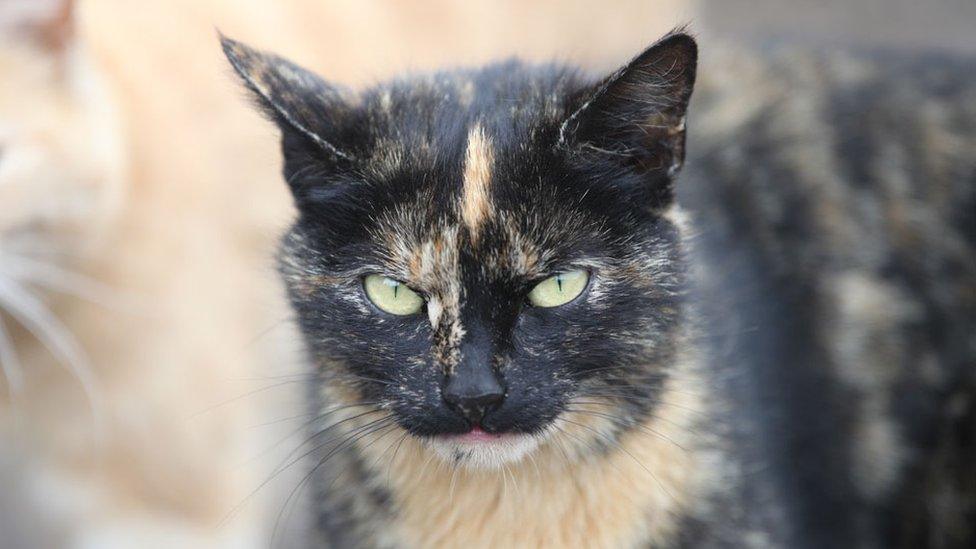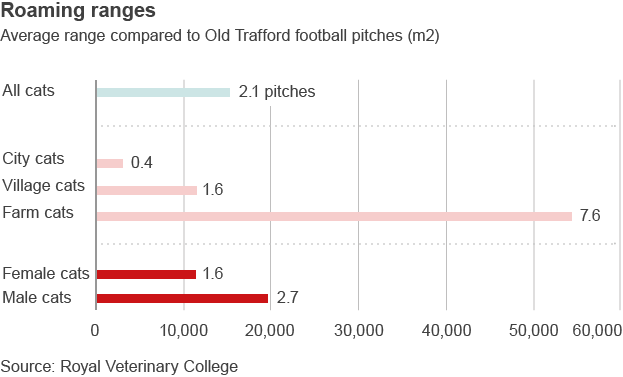Cat Watch 2014: The lion in your lap
- Published
Cats are at a crucial point in their evolutionary journey as they transform from solitary hunters to domestic pets, a study by the BBC and the Royal Veterinary College has revealed.
Our felines are adapting quickly to life in densely-packed cities, changing their behaviour to fit in with our 21st Century lives. They are time-sharing territory with other cats, killing less prey and learning to communicate with each other and people, research for BBC Two's Cat Watch 2014 found.
In the second of a three-part series, we look how our cats' wild genes continue to influence their behaviour.

While our domestic cats may not appear to have much in common with the lions of the Serengeti, they actually share most of the same DNA. In fact, in their relatively recent evolutionary history, they share a common ancestor.
One quirk of these mutual genes is that cats of all sizes - more so than other species, including dogs - require a diet high in protein and rich in meat, driving them to hunt.
A farm cat kills a mouse
A farm cat catches a mouse
However, research by the BBC and the Royal Veterinary College, external shows that among domestic cats, the desire to hunt varies widely - even between those living in the same village.
Some of the 100 felines studied were keen hunters and roamed widely in search of prey, while others showed little interest and only wandered over short distances.

One of the biggest differences was seen between cats living in a densely-packed Brighton terraced street and cats on a farm in south Oxfordshire.
Data provided by the Royal Veterinary College
The competition for space in the city means many of the cats have to compete for territory - especially when a newcomer arrives.
Smudge the city cat encounters a new, rival cat
Smudge the city cat encounters a feline newcomer on a Brighton terraced street
However, felines whose homes were within the leafy village of Rottingdean, Sussex, also showed a wide range of hunting routines. Sandwich was a particularly active hunter.
Sandwich mimics birds on a hunting expedition
Sandwich the cat mimics bird sounds to catch prey.
Differences in behaviour could be down to how cats were treated in the first weeks and months of their lives, such as whether they were taught the skills of hunting by their mothers, says Dr John Bradshaw of the University of Bristol. But it also illustrates how cats are at a key point in their journey to domestication.
"The domestic cat, despite its name, is not actually a fully domesticated species. It retains a lot of the abilities of the wild ancestor, so that it can flip between a fully hunting wild-type existence to a very domesticated existence curled up by somebody's fire - literally within a generation or two," Bradshaw says.
"The domestic dog has gone down the whole way to the end of domestication - fully domesticated. The domestic cat is still, perhaps, only half way."
Watch the first episode of Cat Watch 2014: The New Horizon Experiment on Tuesday 7 October on BBC Two at 8pm or afterwards on the BBC iPlayer. Subsequent episodes will be shown on Wednesday 8 and Thursday 9 October.
For further information, you can download a free interactive ebook Guide to Your Cat featuring analysis, advice and case studies. You can follow the series on Twitter @BBCcats, external
You can also try out three interactive videos, featuring footage of newborn kittens, a cat on a hunting expedition and city cats competing for territory.

The Mammal Society is mapping the distribution and density of cat populations across the UK. The atlas of domestic and feral cats, or CATlas, will also assess their impact on wildlife. To take part in the survey, visit the Mammal Society website, external and fill in the online form.
With thanks to Professor Alan Wilson of the Royal Veterinary College, Dr John Bradshaw and Dr Rachel Casey of the University of Bristol, Dr Sarah Ellis of the University of Lincoln, the residents of Hanover Street, Brighton, the villagers of Rottingdean, Sussex and farmer David Hicks.
Written and produced by Lucy Rodgers. Design by Laura Cantadori. Development by Christopher Ashton and Nzar Tofiq.